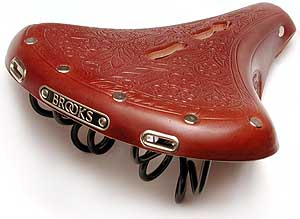Everybody wants a comfortable saddle on their bicycle. What is not so obvious is what constitutes a comfortable saddle.
You'll notice that I do call them "saddles," not "seats." There is a reason for this. A "seat" is something you sit on, and is designed to bear essentially your entire weight. Recumbent bicycles have "seats," but conventional upright bicycles have saddles. A saddle is intended to carry some, but not all of your weight. The rest of your weight is mainly carried by your legs, and some by your hands and arms.
A cyclist who is out of cycling shape, from being off a bicycle for a bit, will start out strong, but the legs will tire rapidly. When the legs tire, the rider sits harder on the saddle, and that's when the trouble starts. Many saddle complaints are actually traceable to fatigue caused by starting out the season with a longer ride than you are ready for.
Hard or Soft?
When a cyclist finds a saddle uncomfortable, the first impulse is often to look for a soft one. This is often a mistake. Just as the softest mattress is not necessarily the most comfortable to sleep on, the softest saddle is not the most comfortable to cycle on.
Imagine sitting down on a coffee table. Your weight is concentrated on the two bumps of your "sit bones", also known as the "ischial tuberosities." These are the parts of your body designed to bear your seated weight. Most cases of saddle-related discomfort arise because the load is carried on the soft tissues between the sit bones.
Imagine placing a soft pillow on top of the coffee table. Now, as you sit down on it, the sit bones compress the pillow, which yields until the sit bones are almost on the table surface again. The difference is that now, you have pressure in between your sit bones from the middle part of the pillow.
Many cyclists are unaware of this, and many saddles are made to appeal to the purchaser who chooses a saddle on the basis of how easily the thumb can sink into the squishy top. This type of saddle is only comfortable for very short rides, (though an inexperienced cyclist will often find it more comfortable than a better saddle, as long as rides don't exceed a mile or two). Saddles with excessive padding are also a common cause of painful chafing of the inner thigh, as rides become longer.
OK, so you want a minimalist saddle which is just wide enough to support your sit bones.
Most saddles are designed for men, not for women. Due to the wider hips of most women, this can result in the sit bones overhanging a narrow saddle, leading to painful pressure on soft tissues.
In general, women's saddles are somewhat wider and somewhat shorter than those that work best for men. Some newer women's saddles have a large cutout in the middle to eliminate pressure on soft tissues. These work well for many women, but some riders find the sharp-ish edges of the hole irritating.
My solution is a tensioned leather saddle (Brooks!):
 Until the mid 1970s, most good quality bicycles came with tensioned leather saddles. These have a frame basically similar to that of the padded plastic saddle. A thick piece of leather is rivetted to the bridge, and to an adjustable fitting at the nose of the saddle. The leather is suspended sort of like a hammock.
Until the mid 1970s, most good quality bicycles came with tensioned leather saddles. These have a frame basically similar to that of the padded plastic saddle. A thick piece of leather is rivetted to the bridge, and to an adjustable fitting at the nose of the saddle. The leather is suspended sort of like a hammock.A properly shaped leather saddle is an excellent choice for the high-mileage rider who doesn't mind the fact that it is a bit heavier than a plastic saddle.
Leather saddles provide "give" by stretching and flexing, without the need for foam padding. The lack of foam greatly improves comfort in hot weather, as heat and perspiration can "breathe" through the porous leather.
Leather saddles also "break in" to fit the particular shape of the rider, in much the same way as a baseball glove does (or a fine pair of shoes!). They do require more care than plastic saddles.
I have a Brooks B17 and a Brooks B72. No, you can't have either of them, I love them both. Best of luck finding your perfect saddle!